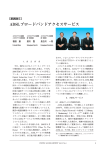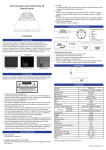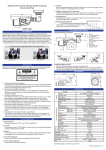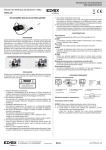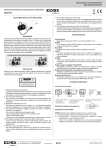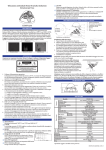Download Siemens HA 8000 (22) P/T SD Technical data
Transcript
HA 8000 (22) P/T SD Illustration Controls 1 2 3 4 5 6 7 8 9 10 11 12 13 Name keys labeling card Program key (SET) R key Last number redial key (REDIAL) Micophone off key (MUTE) Volume key (HIGH) Volume key (LOW) Handfree and all person listen key Keypad Handfree Micophone In-Use LED indicator Handfree LED indicator Catalogue Startup Important Information ………………………………………………… Contents of the package ………………………………………………. Hooking up the equipment ……………………………………………. Note on installing your equipment ……………………………………. 2 3 4 5 Basic settings Checking the signaling method set ……………………………………. Setting the signaling method ………………………………………….. Adjusting the ringer volume ………………………………………….. Setting the handset volume …………………………………………… Adjusting the ringer tone sequence …………………………………… Setting the tone ringing melody ………………………………………. 6 6 7 7 8 8 Dialing with the euroset 812 Dialing with the keypad ………………………………………………. On-hook dialing ………………………………………………………. Last number redial ……………………………………………………. Saved number redial (notepad) ……………………………………….. Retrieving a saved number (notepad) ………………………………… Dialing with the name keys …………………………………………… Muting the microphone ……………………………………………….. Storing name keys …………………………………………………….. Storing number in the name key while making phone calls…………… 9 9 10 10 11 11 11 12 12 Making phone calls with and without the handset Activating handsfree mode ……………………………………………. Adjusting the loudspeaker volume ……………………………………. Deactivating handsfree mode …………………………………………. Allowing others to listen in on a call ………………………………….. 13 13 14 14 Catalogue Remote control, data transfer Temporary swithover of the signaling method……………… 15 Important information for users Taking care of your telephone……………………………….. 16 If your telephone malfunctions………………………………. 16 Technical data………………………………………………... 16 Quick reference guide………………………………………... 17 Labels………………………………………………………… Back cover Startup Important information Signaling method Before using your telephone, you should check the signaling method and set the correct method if necessary. HA 8000(22) P/T SD is set to dual-tone multi-frequency signaling in home. Signaling method setting Pulse=Pulse dialing DTMF=Dual-tone multi-frequency dialing 2 Startup Contents of the package 3 1. euroset 812 4. Telephone connecting cable 2 .Handset 5.Operating instructions 3. Handset connecting cable 6. Telephone guarantee Startup Hooking up the equipment Once a few simple connections have been made, your telephone is ready for operation: 1. Coiled handset connecting cable • Long straight end of the handset connecting cable: Insert the connector into the smaller socket on the bottom of the unit until it clicks into place. Place the cable in the side cable guide. • Connect the coiled end to the handset. 2. Connecting cable • Insert the connector into the larger socket on the bottom of the unit until it clicks into place.Place the cable in the cable guide. • Attach the connector to your telephone jack. Your euroset 812 is now ready for operation. 4 Startup Notes on installing your equipment: We recommend placing the equipment on a non-slip surface. In view of the wide range of varnishes and polishes used for furniture nowadays, the possibility of the surface being marked as a result of contact with the equipment cannot be completely ruled out. Make sure that the equipment is not exposed to direct sunlight or to other sources of heat. To ensure good sound quality in handsfree mode, the telephone should be placed on a smooth surface and the area to the right of the front of the telephone kept clear. Adequate lighting is necessary in order to read the display. 5 Basic settings Checking signaling method set Lift the handset ;you will hear a dial tone. Dial any digit e.g. 5 When you no longer hear a dial tone, the signaling method is set correctly. Go on to the next page. If you still hear the dial tone, this means that you must set the signaling method (see below) Replace the handset. Notes: If the telephone is operated in a home telephone system (PABX), you may not hear a dial tone when you lift the handset. In this case, dial the code of an internal party. If you hear a ringing signal, the signaling method is set correctly. Setting the signaling method If the signaling method is not set correctly, you must reset it: Lift the handset. Press the SET key and… Then the # key, Followed by 1 for pulse dialing or 2 for DTMF. Press the SET key to save the value Replace the handset. 6 Basic settings Adjusting the ringer volume The ringing signal is preset to the maximum volume (level 6) Lift the handset or press the loudspeaker key. Press the SET key. Press key 5 The set ringing signal sounds so that you can check it. Press key 1;the ringer is switched to low volume ( minimum). The volume is set in the same manner for keys 2 through 5. Press key 6;the ringer is set to high volume (maximum). The selected volume is saved when you press the SET key. When telephone ringing; You can also hold down the (HIGH) or (LOW) key instead of pressing digits 1-6.The volume increase or decreases one level every 1/2 sec.Until the minimum or maximum volume is reached.The value last set is saved. Setting handset volume: There are 3 handset volume settings (factory setting: level 1) Lift the handset Then start the function Press the plus or minus key. Or press 1 through 3,choose the handset volume. Press the SET key Replace the handset 7 Basic settings Adjusting the ringer tone sequence You can adjust the ringer tone sequence in 4 stages, the tone sequence is preset to stage 4. Lift the handset Press the SET key Then press key 6, the ringer sounds so that you can check it E.g. if you press key 3 Press the SET key to confirm your setting. This saves the setting. Notes: All settings which are begun with the SET key must also be terminated with the same key. Only then will the desired settings be stored. Therefore, if you do not press SET key at the end of an adjustment, any settings or changes made will not be saved. The original settings remain in effect. You can abort a procedure simply by replacing the handset. Instead of lifting the handset, you can also press the SPEAKER key. Setting the tone ringing melody 10 different melodies can be set for tone ringing (factory setting: melody 0). Lift the handset Then start the function, you will hear the ringing Press one of the key 0…9 Press SET key Replace the handset 8 Dialing with the euroset 812 Dialing with the keypad Lift the handset Dial the desired call number e.g. 412314 Now make the phone call and hang up at the end of the conversation Notes: • You can manually dial numbers of any length. • During dialing, you can insert 1-second pauses(P) by pressing the REDIAL key (not in the 1st position) e.g.0 REDIAL 2368. These pauses are then includes in the redial function. On-hook dialing Press the SPEAKER key until the display lights up. Dial the call number: With the keypad, last number redial, saved number redial and name keys. Handsfree mode is now active. See “Making phone calls with and without the handset”. Press the SPEAKER key again to end the procedure. 9 Dialing with the euroset 812 Last number redial Lift the handset Press the REDIAL key. The call number last entered is dialed automatically ( up to 32 digits) Saved number redial Lift the handset Dial the desired call number with the keypad ( or by pressing the REDIAL key). Nobody answers or you hear a busy signal. Press SET key Then press REDIAL key The call number is saved in the notepad. Notes: Only a maximum of 32 digits are transferred to the memory. If there are more than 32 digits, the memory is erased. 10 Dialing with the euroset 812 Saved number redial ( notepad ) Lift the handset Press the SET key Then press the REDIAL key The call number is dialed from the notepad. Notes: The call number remains stored until a new call number is stored in the notepad. Dialing with name keys Lift the handset Wang Press the desired name key ( for one of the 10 destinations) . If a phone number has not been stored under the name key, follow the procedure described in the section on “Storing and checking name keys”( Page 12) Muting the microphone during a call Sometimes you want to temporarily prevent the other party from listening in on a conversation in the room. Make the phone call as usual. Press the MUTE key. The microphone is deactivated. While you can hear the other party, he cannot hear you. The status is indicated on the display. Press the MUTE key again to restore the old status. 11 Dialing with the euroset 812 Storing and checking name keys Lift the handset Press SET key Wang Press the desired name key for one of the 10 destination. Enter the call number to be stored up to 32 digits; the old call number is erased. Press the SET key again. The new number is stored under the name key. Write the name on the label. You have called a party and would like to store this number under a name key. Conduct a call… Press the SET key Wang Then press the name key for one of the 10 destinations. Press the REDIAL key. The number is transferred from the REDIAL key and stored under the selected name key. Press the SET key again. 12 Making phone calls with and without the handset In handsfree mode, you can make phone calls with the handset on-hook. This allows you to keep your hands free. For this purpose, the telephone has a small opening with a microphone in the right-hand corner. This opening must remain unobstructed in order to use handsfree mode. There should be no objects in front of it, and there should be no tablecloth under the telephone. If you lift the handset and activate the loudspeaker, you are in open listening mode. The handsfree microphone is deactivated and you can talk only through the telephone handset. The other party can be heard over the loudspeaker. Activating handsfree mode-both hands are free Conduct a phone call with the handset Press the SPEAKER key, hold it down and replace the handset. You can now continue the call with both handsfree. Adjusting the loudspeaker volume The loudspeaker is activated Then press the plus key ( HIGH) Or… The minus key (LOW) Each time you press the plus or minus key, the loudspeaker volume is raised or lowered. You can adjust the volume on 7 levels (1-7).The value last set is saved automatically. You can also adjust the volume by holding down the (HIGH) or (LOW) key. Notes: For optimum results, you should position yourself approx. 50 cm from the handsfree microphone. Volume level 7 is the maximum level in the case of calls with normal attenuation (normal volume).The voice-controlled handsfree equipment can function properly only if the two calling parties do not speak at the same time. Any line and ambient noise that occurs will impair the handsfree quality, as will calls being conducted by other people in the background. When the calls are very quiet, you should use the handset. 13 Making phone calls with and without the handset Deactivating handsfree mode You want to switch from handsfree mode to normal phone mode. Lift the handset. The loudspeaker and built-in microphone are deactivated automatically. Allowing others to listen in on a call Press the SPEAKER key While conducting a call with the handset. Other people can now listen to the call via the telephone loudspeaker. You can then deactivate the loudspeaker by pressing SPEAKER again. Notes: Open listening is always active when the loudspeaker is on and the handset is offhook. The built-in microphone is deactivated. Handsfree mode is always active via the built-in microphone when the loudspeaker is on and the handset is on-hook. 14 Remote control, data transfer Temporary swithover of the signaling method If your telephone is connected to an exchange with pulse dialing (pulse), you must temporarily swith your phone over to dual-tone multi-frequency signaling (DTMF), as described below, in order to operate a device such as an answering machine by remote control or to perform a data transfer. Conduct a call… Press the * key You can now enter the appropriate numbers for the services. At the end of the call, the telephone switches back to pulse the dialing. Notes: You should not use the “switchover of the signaling method” procedure when switching over to DTMF signaling temporarily. Since this will switch over the signaling method permanently (see section on “Basic settings: Setting the signaling method” on page 6). Only the digits entered before switchover are dialed during last number redial. 15 Important information for users Taking care of your telephone Simply wipe the equipment with a damp or antistatic cloth. Never use a dry cloth ( due to static charging) If your telephone malfunctions Not every malfunction means that your telephone has developed an actual fault, if it is a simple one, you are likely to save both time and money if you can trace the cause of it youeself. • No dial tone on lifting the handset, no display: Is the connecting cord properly attached to the telephone and the telephone jack. • You cannot dial out The connection is OK. You must set the correct signaling method. • Interference in handsfree mode, brief interruptions occur: Avoid background noises, e.g. calls made by other people, music, etc. Lower the loudspeaker volume. Move closer to the microphone. If there is a great deal of interference: Conduct the call over the handset. • The other party cannot hear you Is the mute key activated? Press the key again. Is the connector on the handset cable attached properly? • In conjunction with the PABX systems only: No connection or wrong connection when dialing from the memory. Program an exchange code. Technical data Pin assignments of the connecting cord socket on the bottom of the telephone set: 16 Quick reference guide Store the telephone number under the name key. Wang Number ringer volume 1-6 choose ringer 1-4 Saved number redial Number Saved number redial ( notepad ) 17



















